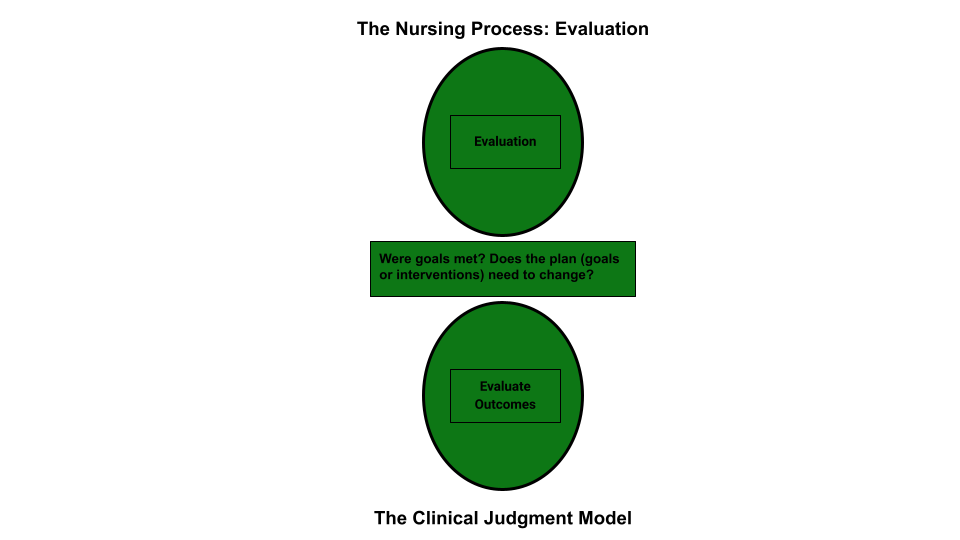 NCSBN Clinical Judgment Model" width="960" height="540" />
NCSBN Clinical Judgment Model" width="960" height="540" />
Evaluation is the sixth step of the nursing process (and the sixth Standard of Practice by the American Nurses Association). This standard is defined as, “The registered nurse evaluates progress toward attainment of goals and outcomes.” [1] Both the client status and the effectiveness of the nursing care must be continuously evaluated, and the care plan modified as needed. [2]
Evaluation focuses on the effectiveness of the nursing interventions by reviewing the expected outcomes to determine if they were met by the time frames indicated. During the evaluation phase, nurses use critical thinking to analyze reassessment data and determine if a client’s expected outcomes have been met, partially met, or not met by the time frames established. If outcomes are not met or only partially met by the time frame indicated, the care plan should be revised. Reassessment should occur every time the nurse interacts with a client, discusses the care plan with others on the interprofessional team, or reviews updated laboratory or diagnostic test results. Nursing care plans should be updated as higher priority goals emerge. The results of the evaluation must be documented in the client’s medical record. Evaluation is outside the scope of practice for LPN/VNs, but they may assist in collecting reassessment data for the RN to evaluate.
Ideally, when the planned interventions are implemented, the client will respond positively, and the expected outcomes are achieved. However, when interventions do not assist in progressing the client toward the expected outcomes, the nursing care plan must be revised to more effectively address the needs of the client These questions can be used as a guide when revising the nursing care plan:
See Figure 4.15 [3] for a comparison of the Evaluation phase of the nursing process to the NCSBN Clinical Judgment Model.
 NCSBN Clinical Judgment Model" width="960" height="540" />
NCSBN Clinical Judgment Model" width="960" height="540" />
See an example of the Evaluation phase in the following box.
Example of Evaluation
Refer to Scenario C in the “Assessment” section of this chapter and Appendix C. The nurse evaluates the client’s progress toward achieving the expected outcomes.
For the nursing diagnosis Excess Fluid Volume, the nurse evaluated four expected outcomes to determine if they were met during the time frames indicated:
Evaluation of the client condition on Day 1 included the following data: “The client reported decreased shortness of breath, and there were no longer crackles in the lower bases of the lungs. Weight decreased by 1 kg, but 2+ edema continued in ankles and calves.” Based on this data, the nurse evaluated the expected outcomes as “Partially Met” and revised the care plan with two new interventions:
For the second nursing diagnosis, Risk for Falls, the nurse evaluated the outcome criteria as “Met” based on the evaluation, “The client verbalizes understanding and is appropriately calling for assistance when getting out of bed. No falls have occurred.”
The nurse will continue to reassess the client’s progress according to the care plan during hospitalization and make revisions to the care plan as needed. Evaluation of the care plan is documented in the client’s medical record.
Nursing Fundamentals 2e Copyright © by Open Resources for Nursing (Open RN) is licensed under a Creative Commons Attribution 4.0 International License, except where otherwise noted.